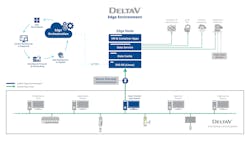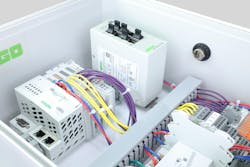Scaling IIoT Across Operations and into the Enterprise
Why this article is worth your time:
- Discover which production functions hold the keys to the predictive and preventive maintenance, quality management and sustainability use cases.
- Learn how industrial packaging company Amcor uses HMI/SCADA visualization, analytics dashboards and MQTT to move beyond connecting individual assets to create a more holistic picture of operations.
- Find out how Saint-Gobain Glass developed an energy management system to connect and manage electricity meters, visualize and remediate local consumption, and stream data to a central data lake to support global KPIs and plant-to-plant comparisons.
The first part of manufacturing’s digital transformation journey to date has centered on establishing IIoT (industrial Internet of Things) connectivity for machinery and devices through a network of diverse sensors, gateways and I/O modules to collect, aggregate and prepare plant floor data for analysis and action, whether at the edge or in the cloud.
These efforts were made to release critical time-series and other industrial data from their operations technology (OT) silos, enabling the data to be harnessed at a broader scale to fuel predictive analytics and other AI-enabled applications aimed at redefining and upleveling manufacturing through more intelligent operations.
“To have the factory floor become fully intelligent, you need IIoT to collect the data, process it and aggregate it to enable a condition monitoring application [that can let you] know ahead of time if a machine or a production line has a problem and avoid unplanned downtime,” noted Kelsie McMillin, a senior marketing specialist for IoT at DigiKey, a supplier of electronics components.
Advances in wireless network technologies, coupled with the proliferation of factory-floor Wi-Fi to facilitate machine sensor connectivity, are further fueling the number of devices and assets linked via IIoT systems. To give you an idea of how fast IIoT device connections are proliferating, consider this insight from IoT Analytics: There were 16.6 billion connected IoT devices at the end of 2023; that number is expected to surge to 40 billion by 2030.
Ethernet-APL is poised to be crucial for scaling IIoT connectivity and digital transformation activities via its high-speed data transfer capabilities.
Integration, security and data management issues still hinder IIoT connectivity
Despite all the connectivity momentum across industry, IIoT-enabled digital transformation activity remains somewhat contained, oftentimes limited to individual specialty equipment or a single plant floor facility. Integration complexities, ongoing security concerns, data management challenges and high costs have kept many efforts in check.
To date, most of the data that has been collected and acted upon focused on monitoring and controlling production process and the products being made. Much of this data has not yet been contextualized and/or made available to systems in areas like maintenance, energy management or even manufacturing enterprise backbones like MES (manufacturing execution systems) and ERP (enterprise resource planning).
Driven in part by the promise of AI (artificial intelligence), manufacturers have been stepping up efforts to work through these challenges and pursue IIoT-enabled digital transformation initiatives that tap into data that lives both inside and outside the plant floor. This is being done in reaction to the knowledge that frequently siloed functions, such as maintenance, vibration monitoring and energy management systems, hold the keys to the predictive and preventive maintenance, quality management and sustainability use cases that become possible with unified data, AI and greater compute power at the edge and in the cloud.
“The whole premise of digital transformation is to eliminate those individual silos that have existed for some time,” explained Doug Warren, senior vice president of monitoring and control at Aveva. “With IIoT connectivity, we’re collecting additional sensor inputs and merging them into a broader platform that also collects and manages the manufacturing-specific data we’ve traditionally had.”
Amcor reduces downtime with Aveva’s Operations Center
Industrial packaging company Amcor is using Aveva’s Operations Center software to facilitate the collection, sharing and analysis of its operations data.
Aveva positions its Operations Center platform as a single pane of glass that addresses both on-premises and cloud applications. Through capabilities like HMI/SCADA visualization, analytics dashboards, MQTT support and integration with Aveva’s Connect cloud platform, Operations Center helps manufacturers move beyond connecting individual assets to create a more holistic picture of operations, Warren said.
A key aspect of Operations Center’s ability to do this is via its use of unified namespace (UNS), which enables diverse IIoT data to be collected and contextualized in an understandable way.
In the first phase of Amcor’s digital transformation, the company focused on plant floor operations, improving OEE (overall equipment effectiveness) in its blow molding processes and gaining full visibility of asset utilization and energy performance. In phase two, the company added Aveva Connect’s cloud-based analytics to mitigate ongoing downtime issues caused by faulty molding equipment and the associated frequent and costly maintenance.
An energy management system at Saint-Gobain Glass allows personnel to connect and manage electricity meters, visualize and remediate local consumption, and stream data to a central data lake to support global KPIs and plant-to-plant comparisons.
With this software duo, “Amcor was able to get standardized views of OEE across lines operating around the world to reduce downtime by 1% to 2%,” Warren said.
The next step for Amcor involves use of IIoT-enabled holistic visibility to tackle energy consumption and equipment monitoring.
Saint-Gobain Glass connects plant floor devices with Inductive Automation’s Ignition
Leveraging open standards like MQTT and OPC UA, Inductive Automation’s Ignition platform bridges device data with SCADA systems and HMI screens to visualize operations data via dashboards and reports, whether on premises or in the cloud.
“Ignition’s biggest role is to connect data, model and contextualize it, and get it where it needs to go,” said Travis Cox, chief technology evangelist at Inductive Automation.
Over the past few years, a number of manufacturers trended towards SaaS (software-as-a- service) offerings to directly connect industrial equipment to the cloud for specialized use cases like vibration analysis. Yet those systems were often limited to individual assets and often became yet another data silo, Cox explained. Now, as manufacturers seek to expand IIoT at the enterprise level, they need contextualized and consolidated data for AI uses cases, as well as a path to avoid vendor lock in, he said.
As a case in point, Cox referenced Saint-Gobain Glass’s use of Ignition to create a holistic picture of its global operations across a hybrid architecture of local real-time data and data stored in the cloud. Saint-Gobain Glass embarked on this project when it realized its operations were being held back by inconsistent processes and fragmented data silos. As a result, the manufacturer lacked comprehensive visibility into its global operations, which slowed decision making.
In the first phase of Amcor’s digital transformation, the company focused on plant floor operations, improving OEE in its blow molding processes and gaining full visibility of asset utilization and energy performance. In phase two, the company added cloud-based analytics to mitigate ongoing downtime issues caused by faulty molding equipment and the associated frequent and costly maintenance.
With Ignition, enterprise data is now collected and organized in a consistent fashion, allowing for real-time analysis and live visualizations. In one sample use case, an energy management system at Saint-Gobain Glass allows personnel to connect and manage electricity meters, visualize and remediate local consumption, and stream data to a central data lake to support global KPIs (key performance indicators) and plant-to-plant comparisons.
Seadrill uses Wago’s IoT Box for real-time monitoring
Scalable connectivity of industrial devices is another key challenge to enabling real-time data collection and analysis, according to Tyrone Visser, head of Smart Factory - Automation Excellence for Wago Americas. Wago’s plug-and- play IoT Box helped Seadrill, a provider of offshore drilling services, address those issues when it began looking to monitor and optimize energy consumption across its global drilling fleet. Seadrill also wanted to minimize the complexity of deploying and managing devices across its different locations.
“They needed a scalable IoT solution that would help reduce carbon across their fleet while avoiding vendor lock in,” Visser said.
Wago’s IoT Box was deployed in conjunction with Cedalo Mosquitto MQTT technology to enable real-time data streaming from the drilling fleet and Portainer for edge device management, allowing for centralized monitoring and remote software updates for hundreds of devices across multiple regions. The open architecture approach supported by the IoT Box, Cedalo and Portainer ensured the collected data could be integrated into various enterprise platforms, including the company’s ERP systems, databases and analytics tools.
How Ethernet-APL is helping industry scale IIoT
As can be seen in the three examples noted above, manufacturers are clearly advancing their use of IIoT connectivity for numerous practical use cases. However, several factors continue to slow progress.
For example, the complexity of integration, inadequate data foundations and the inability of many vendors to support advanced scaling of connectivity. Bain & Company found that 80% of companies pursuing IIoT projects are scaling fewer than 60% of their pilot projects for those very reasons.
Security remains another significant hurdle. Scaling IIoT means bringing together critical data, which raises concerns about hacking vulnerabilities and compliance risks.
“As we consolidate data, we’re creating a single point for proprietary information about how the plant operates. This can make it (plant operations technology) a bigger target,” noted Sean Vincent, director of technology programs for the FieldComm Group, a non-profit member organization that serves as the caretaker of HART and Foundation Fieldbus standards along with responsibility for the ongoing development of newer technologies like Field Device Integration (FDI) and Ethernet-APL (advanced physical layer).
Ethernet-APL is a new standard for process automation that uses single twisted pair wiring, often referred to as single pair Ethernet. This is poised to be crucial for scaling IIoT connectivity and digital transformation activities via its high-speed data transfer capabilities.
But here too, a robust security paradigm for addressing cybersecurity concerns is crucial, said Claudio Fayed, vice president, process systems and solutions for Emerson. “The adoption of APL technology requires a process to manage and secure what are now becoming IP internet nodes on the plant floor,” he said.
Emerson’s Delta V Edge Environment, which delivers a read-only replica of contextualized control system data for use across the enterprise — to protect against bad actor cyber uses of such data — supports Ethernet-APL devices and APL switches.
More IIoT and industrial networking insights from Automation World:
About the Author
Beth Stackpole, contributing writer
Contributing Editor, Automation World

Leaders relevant to this article:


